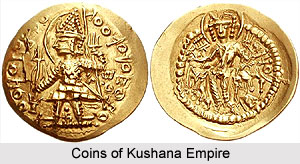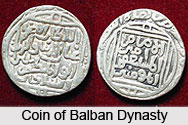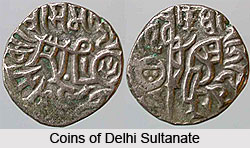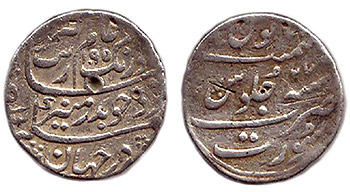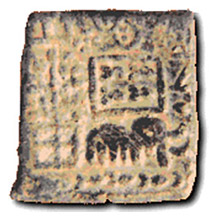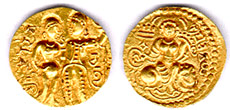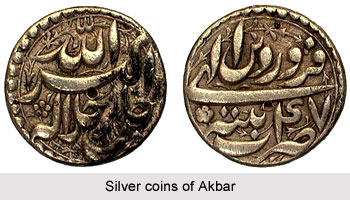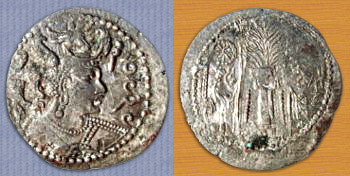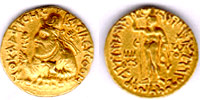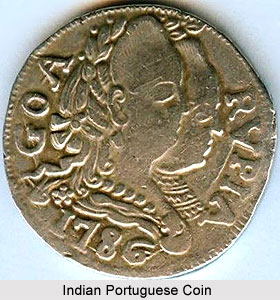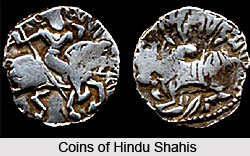 Coins of Hindu Shahis included both foreign and local coinages. In addition to the natural products of the Gandhara region, the Shahi kings drew revenue from the constant caravan trade passing through their dominions. Moreover, the Hindu Shahis exploited the rich silver deposits of the Panjshir valley, renowned for its extensive workings and the speculative courage of its mine promoters. With such resources of foreign coinage and raw precious metal, it is not surprising that a distinctive local coinage evolved. The Hindu Shahis issued a regular coinage of silver and copper. The obverse of the silver coin bore the figure of a seated bull and a Devanagari legend, while the reverse had the figure of a mounted warrior. Copper coins were also issued by the Hindu Shahis. The earliest appear to have been modelled on the silver coins, with the same motifs and weight standard. Later issues were changed, and the reason is not hard to deduce, since the use of identical designs for base and precious metal coins encouraged fraud. In the event, the design of the obverse became a caparisoned elephant with Devanagari legend, and of the reverse, a lion rampant.
Coins of Hindu Shahis included both foreign and local coinages. In addition to the natural products of the Gandhara region, the Shahi kings drew revenue from the constant caravan trade passing through their dominions. Moreover, the Hindu Shahis exploited the rich silver deposits of the Panjshir valley, renowned for its extensive workings and the speculative courage of its mine promoters. With such resources of foreign coinage and raw precious metal, it is not surprising that a distinctive local coinage evolved. The Hindu Shahis issued a regular coinage of silver and copper. The obverse of the silver coin bore the figure of a seated bull and a Devanagari legend, while the reverse had the figure of a mounted warrior. Copper coins were also issued by the Hindu Shahis. The earliest appear to have been modelled on the silver coins, with the same motifs and weight standard. Later issues were changed, and the reason is not hard to deduce, since the use of identical designs for base and precious metal coins encouraged fraud. In the event, the design of the obverse became a caparisoned elephant with Devanagari legend, and of the reverse, a lion rampant.
The temporal principles of continuous coinage systems of Hindu Shahis were many. Like for instance, in case of a change in coin weight standard, it would decline with passing time; in case of a change in metal content, the relative proportion of precious metals would decline with time; and in case of an evolution in design, the standard of execution would decline in time, or the design would become increasingly stylised. This in turn confirms the hypothesis that Spalapati issues were generally issued earlier in Afghanistan, while Samanta and other issues were generally issued later in India. The copper coins of the Hindu Shahis seem to have been a token coinage intended for local circulation. The lion design bore some resemblance to a silver coin, which by its distinctive Sarada legend is attributable to the Shahi kingdom or Kashmir, about this period. Its weight standard is that of the silver coins. The silver bull-and-horseman coins of Hindu Shahis break down naturally into two major classes, bearing legends sri `spalapati deva` and in `samanta deva`; and two minor classes bearing legends sri khudaraiyaka deva and mahttna deva.
Coins of Hindu Shahis as Trade Currency
The conspicuous imitation of the Shahi coinage by lesser and later political regimes is strong testimonial to the acceptance and trust which Shahi coinage got in areas beyond their borders. The Shahi bull-and-horseman silver coins probably saw circulation beyond borders in the tenth century. It was indisputably the dominant money of Afghanistan and north-western India in that period. Further, its reputation was based on its long-term stability of metal content. The Hindu Shahi coinage was remarkably steady in silver content. In the eighth century, the free exchange ratio of Pratihara and Hindu Shahi currency would have been around 117 to 100; by the late eleventh century it would have declined to 220 to 100. Later, much of the depot trade of the Shahi territories had ultimately found its way into the Gangetic valley ruled by the Pratiharas. It has been noted by historians that a trustworthy currency was a boon to traders, and a precondition of successful long-range trade. Several evidences establish the fact firmly that the silver coins of Hindu Shahis had been widely accepted as a trade coinage in that era.
Thus, it can be said that under Hindu Shahi dynasty, a bimetallic silver-copper currency system operated. The copper coinage remained local in nature, while the influence of the silver bull-and-horseman coinage was felt far away. The coin type was of stable intrinsic metal value and this was the basis of its renown; it became in effect a trade currency circulating far beyond the kingdom`s borders. Despite the fall of the issuing dynasty, contemporary and later governments with their imitation coinages, kept the type alive in Northwest India.
